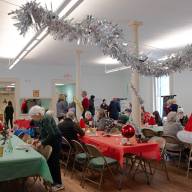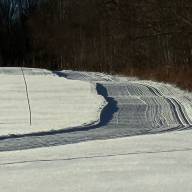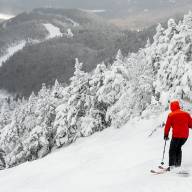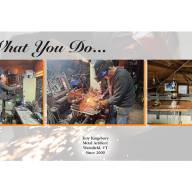By Tracy Brannstrom
An art exhibition called “Rise: Trees, Our Botanical Giants,” is up through April 29 at Mad River Valley Arts (MRVA) in Waitsfield. It features artworks in a variety of mediums from 28 artists from across Vermont and elsewhere, taking up themes of ecology, resilience, destruction, climate change and others.
On April 18 at 5 p.m., the gallery will host a presentation by ecologist Shelby Perry of the Northeast Wilderness Trust, called “Trees and Rewilding.”
MRVA executive director Sam Talbot-Kelly said she conceived of curating a show about trees because her mother, who contracted tuberculosis at 16 years old, had trouble breathing her whole life. “I live next to the woods and see trees from every window in my house from different perspectives and proximities,” Talbot-Kelly said. “And I had an aha moment one day, thinking that humans are in a cycle of breath with trees. It is obvious science, but this fact became crystal clear in a miraculous way.”
SEEING SOLACE
Many works in the show emphasize cycles of life and death – with continuity and resilience on one hand, and the destruction wrought by human-made disaster on the other.
North Carolina-based Diane Bronstein wrote in the show’s program that her work – a vintage photograph with embroidery running through it – deals with the constancy and adaptability of the natural world. “My work recognizes a world where nature radically overtakes and changes our everyday life without our acknowledgement,” she wrote, as “lava breaks through roads, wild vines crawl over buildings, [and] trees grow in the middle of rooms.”
Through a series of charcoal drawings, Julie Comnick’s work highlight the resilience of Ponderosa pines, even as they’re downed by a violent windstorm in Arizona. “These images metaphorically reflect the turbulence of our times, which are shrouded in a global health emergency, the climate crisis, national political upheaval, and civil unrest,” she said.
Montpelier-based Mary Admasian, too, is interested in what she called “an environment of volatility.” Her sculptures – made from reclaimed wood, barbed wire, rusted metal, and other materials – are inspired by how trees are marked with blue paint before getting cut down and discarded, or used as building materials.
But “even in moments of deepest sorrow,” Beth Kendrick wrote in the program when describing her work, “there is beauty to be found within the cycle of life and death.” Her mixed media collage “Mother Tree” highlights how humans seek solace in the natural world, spending time with trees during periods of loss and grief.
LAYERS UPON LAYERS
Themes of interconnection and ecology are also present throughout the show. Andrea Stix Wasserman, who works in gouache on paper, points to forms of relation that aren’t easily perceptible – “from the net carbon transfer between mother trees with shared ectomycorrhizal fungi, to the decomposition of leaves that nitrogenate plankton in the oceans,” she wrote, which gesture at “layers upon layers of fragile connections.”
With his etching work, Keith Buswell explored such relationships too. “In 2016,” he wrote, “ecologist Suzanne Simard wanted to find out if trees could talk to each other. What she found was a network of fungi underground connecting the roots of trees that only relayed information to teach other, but also provided nutrients for young and dying plants.”
That finding, he said, was an “an embodiment of community.” In his thinking, Buswell scales from the natural realm to social worlds. “We need our farmers, teachers, and artists just as much as trees need a forest,” he said.
DEEP EXPANSION
Finally, phenomena of time and space are a through-line of the exhibition. Joseph Salerno, who works in oil paint, said he is drawn to rendering liminal spaces – the edge of a forest or the ridge of a mountain, “where form and space interact and one thing becomes another,” he wrote.
His paintings were created in the forest near his Johnson, VT, home, with each work beginning as “a series of marks, strokes, jabs, dabs, globs, glops, scrapes or scratches of paint onto the surface of the paper,” and “with a painting knife, they are worked and shaped and splayed and finessed and tortured and cajoled into telling me something.”
Attending to scales of time, Thomas Crawford employs 1950s-era topographical maps from the United State Geological Service to convey how landscapes formed over millennia. As photographer Julie Parker wrote in the show’s program, trees “have a “rhythm and time scale that is all their own.”
Photographer Ben Erlandson said the purpose of his image “Approaching the Pinnacles,” which was shot through time-lapse, “is to encourage us all to think beyond ourselves, our immediate surroundings, and shallow time horizons, expanding into something deeper and broader than what is an increasingly distracted frenetic existence.”
The gallery, located in the Waitsfield Village Square, is open Tuesday through Saturday from 1 to 5 p.m.
You might also like













